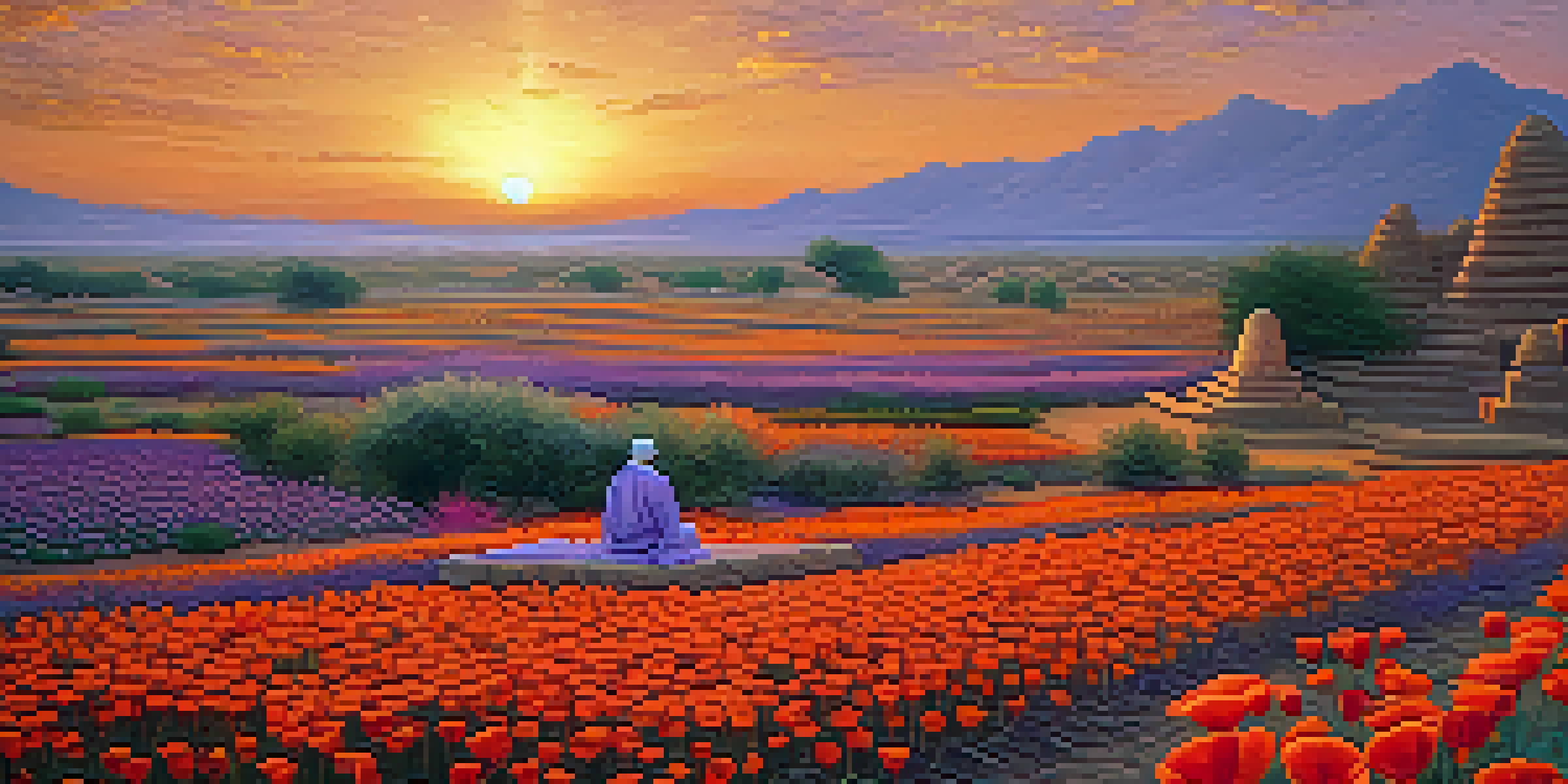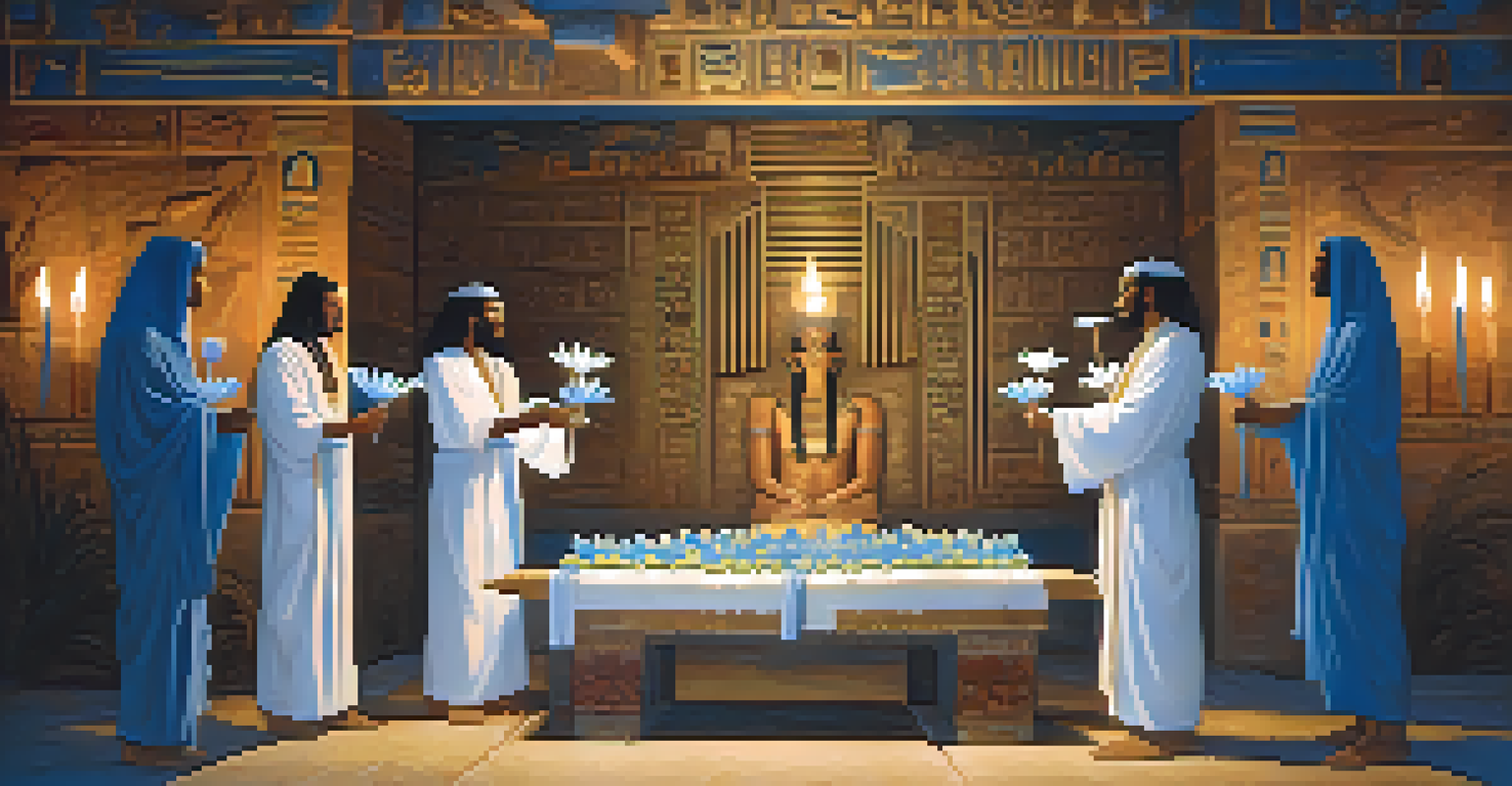Entheogens in Ancient Cultures: A Historical Overview

Understanding Entheogens: A Brief Definition
Entheogens are substances that are used in spiritual or religious contexts to induce altered states of consciousness. The term is derived from the Greek words 'entheos,' meaning 'full of God' or 'inspired,' and 'genes,' meaning 'generated by.' While many people might associate these substances primarily with recreational use today, their historical significance in ancient rituals is profound.
The consciousness-expanding properties of entheogens can help us access deeper layers of our psyche, revealing the interconnectedness of all life.
In various cultures, entheogens were seen as sacred tools for connecting with the divine or exploring the inner self. They often played a pivotal role in shamanistic practices, allowing individuals to access spiritual realms and gain insights. By understanding what entheogens are, we can appreciate their significance in ancient societies.
The exploration of entheogens leads us to uncover how different cultures utilized these substances, shaping their beliefs, rituals, and even social structures. This journey through history reveals the deep-rooted connection between humanity and these powerful natural substances.
Entheogens in Ancient Mesopotamia: The First Users
In ancient Mesopotamia, particularly among the Sumerians and Akkadians, entheogens were integral to religious practices. Archaeological findings suggest the use of various plants, including opium poppy and other psychoactive herbs, in ceremonies designed to invoke the presence of deities. These practices were often conducted by priests who acted as intermediaries between the gods and the people.

The famous Epic of Gilgamesh highlights the Sumerians' belief in the divine connection through altered states of consciousness. Shamans and priests would use these substances to achieve trance states, believed to facilitate communication with the gods. This profound relationship between humans and the divine underscores the importance of entheogens in Mesopotamian culture.
Entheogens in Spiritual Practices
Entheogens have historically been used in various cultures as sacred tools for spiritual connection and exploration of consciousness.
By examining these ancient practices, we can see how the use of entheogens shaped their understanding of life, death, and the cosmos. This foundation laid the groundwork for future civilizations to explore similar spiritual journeys through nature's offerings.
Entheogenic Rituals in Ancient Egypt: A Divine Connection
Ancient Egypt is renowned for its rich spiritual traditions, and entheogens played a crucial role in their religious practices. The Egyptians are believed to have used various psychoactive substances, such as blue lotus and certain fungi, to enhance their connection to the divine. These substances were often consumed during sacred rituals and ceremonies, allowing priests to enter trance-like states.
Entheogens have been part of humanity's spiritual toolkit for millennia, bridging the gap between the seen and unseen worlds.
The Book of the Dead, a key text in Egyptian spirituality, contains references to these rituals, where the use of entheogens was linked to the journey of the soul and the afterlife. The blue lotus, in particular, was celebrated for its psychoactive properties and was often depicted in art as a symbol of rebirth and enlightenment. This illustrates how entheogens were not merely used for pleasure, but as pathways to understanding the mysteries of existence.
Through the lens of ancient Egyptian culture, we see how entheogens facilitated profound spiritual experiences. Their rituals and beliefs surrounding these substances contributed significantly to their understanding of life, death, and the afterlife.
The Role of Entheogens in Ancient Indian Traditions
In ancient India, entheogens were revered as sacred plants that held the key to spiritual awakening. The Vedic texts, which form the basis of Hindu philosophy, describe the use of soma, a mysterious substance believed to induce divine experiences. While the exact identity of soma remains debated, its importance in rituals is unmistakable.
Soma was consumed during elaborate ceremonies, providing practitioners with visions and insights that were thought to connect them with higher realms of consciousness. This practice reflects a broader understanding in Indian traditions that entheogens could facilitate a deeper connection with the universe and the divine.
Ancient Civilizations and Healing
Civilizations like the Sumerians, Egyptians, and Mesoamericans utilized entheogens in rituals to foster communal bonds and facilitate healing.
The legacy of entheogens in ancient Indian culture is still felt today, as many modern spiritual practices continue to emphasize the importance of altered states for self-discovery and enlightenment. This historical context enriches our understanding of the ongoing relationship between spirituality and nature in Indian traditions.
Entheogens in Mesoamerican Cultures: A Sacred Journey
Mesoamerican cultures, particularly the Aztecs and Mayans, are well-known for their use of entheogens like psilocybin mushrooms and peyote. These substances were integral to their religious ceremonies, often employed by shamans to communicate with the spirit world. The consumption of these entheogens was viewed as a sacred journey, facilitating interactions with deities and ancestors.
In these cultures, the rituals surrounding entheogen use were elaborate, involving chanting, dancing, and other communal activities. Participants often reported profound mystical experiences, which reinforced communal bonds and cultural identity. The rich symbolism associated with these substances further elevated their status in Mesoamerican societies.
By exploring the significance of entheogens in Mesoamerican cultures, we gain insight into how these practices shaped their worldview and understanding of existence. The legacies of these ancient rituals continue to influence modern spiritual practices worldwide.
Entheogens and Shamanism: A Global Phenomenon
Shamanism, a practice that spans cultures worldwide, often incorporates the use of entheogens as a means of healing and divination. Shamans, acting as intermediaries between the physical and spiritual worlds, utilize these substances to enter altered states of consciousness. By doing so, they seek guidance from spirits and ancestors, making entheogens a vital part of their practice.
In various indigenous cultures, the role of the shaman is respected and revered, as they harness the power of entheogens to promote healing and community well-being. These substances are seen as gifts from nature, providing insights that can lead to personal and collective transformation. This connection underscores the universal appeal of entheogens in spiritual practices across the globe.
Modern Revival of Ancient Wisdom
Today's growing interest in entheogens reflects a desire to integrate ancient practices with modern wellness approaches for personal growth.
The global phenomenon of shamanism illustrates how entheogens serve not only as tools for personal exploration but also as catalysts for cultural identity and community cohesion. Their significance extends beyond individual experience, weaving into the fabric of collective human history.
Modern Perspectives on Ancient Entheogenic Practices
As we navigate the 21st century, there's a growing interest in the historical use of entheogens, informed by both scientific research and spiritual exploration. Many people are revisiting these ancient practices, seeking to understand their potential for personal growth and healing. This revival reflects a broader trend of integrating traditional wisdom with modern wellness practices.
Contemporary studies have begun to validate the therapeutic potential of entheogens, particularly in addressing mental health issues. This resurgence is reminiscent of the ways ancient cultures utilized these substances for healing and spiritual connection. By bridging the gap between ancient practices and modern science, we can appreciate the timeless relevance of entheogens.

In exploring modern perspectives on ancient entheogenic practices, we see a fascinating interplay between tradition and innovation. As society continues to seek deeper meaning and connection, the wisdom of our ancestors regarding entheogens remains a vital resource.
The Legacy of Entheogens: A Timeless Exploration
The exploration of entheogens throughout history reveals a rich tapestry of human experience intertwined with nature. From the ancient civilizations of Mesopotamia to the spiritual practices of Mesoamerican cultures, entheogens have served as catalysts for spiritual awakening and community bonding. This legacy continues to resonate today as societies seek deeper connections to themselves and the world around them.
By understanding the historical significance of entheogens, we can appreciate their potential for personal and collective transformation. The insights gained from these ancient practices can guide modern spiritual seekers in their journeys, reminding us of our innate desire to connect with the divine.
As we reflect on the legacy of entheogens, it becomes clear that this exploration is not merely historical; it's an invitation to engage with our own consciousness and the mysteries of existence. The timeless nature of entheogenic practices underscores the enduring quest for understanding and connection that has defined humanity for millennia.